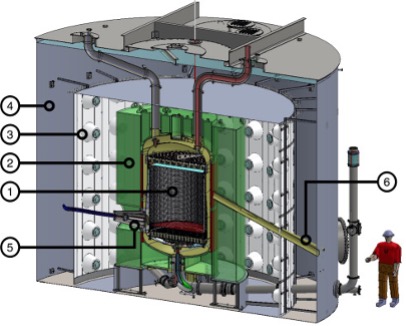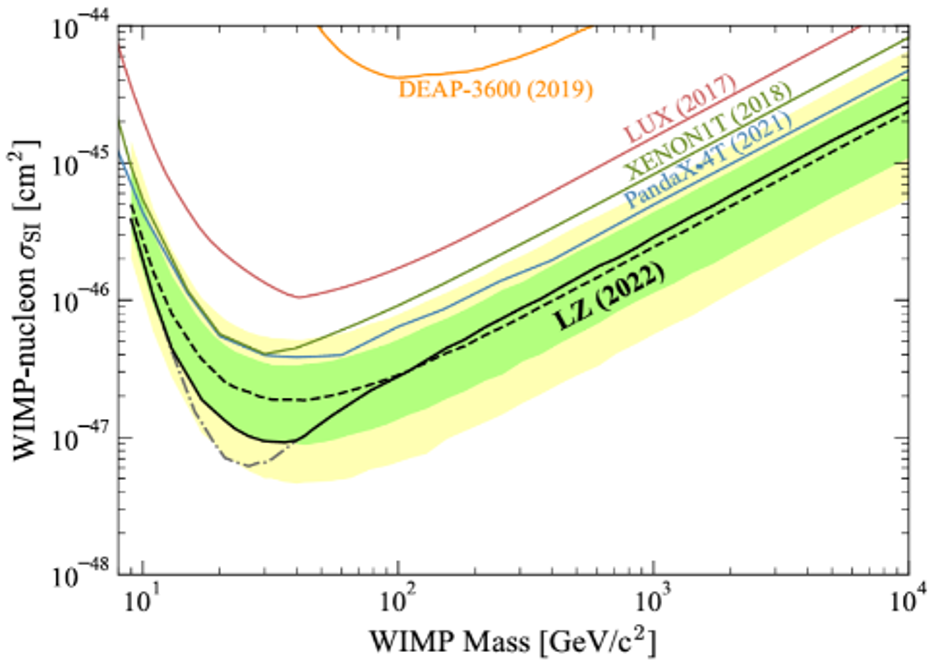LUX-ZEPLIN (LZ Collaboration)
BHSU is a member of the LZ Collaboration
Dark matter Hunt with LUX-ZEPLIN Transcript
Dark matter constitutes about 85% of the mass in the universe [1-4], but its composition and nature remain unknown. Leading theories continue to postulate that dark matter is formed of Weakly Interacting Massive Particles (WIMPs) with masses between ~ 2 and at least 1000 GeV/c 2. The 2023 P5 recommendations highlighted the significance of identifying dark matter for the Office of Science High Energy Physics program. Recommendation 1 emphasizes the importance of the LUX-ZEPLIN (LZ) experiment as it has entered its primary WIMP discovery phase; stating “as one of the highest priorities independent of budget scenario”, that the LZ detector at the Sanford Underground Research Facility (SURF) [5-7] in Lead, SD be one of the experiments to continue to receive support from DOE for “ongoing experiments and research to enable maximum science[8].” Additionally, “an ultimate Generation 3 (G3) dark matter direct detection experiment reaching the neutrino fog, in coordination with international partners and preferably sited in the US” was also recommended by the P5 panel.
The LZ collaboration is a merging of the LUX [9] and ZEPLIN [10] experiments and is searching for the elusive WIMP signal [11-14]. The experiment is located in SURF’s Davis cavern on the 4850L, which provides 4300 meter water equivalent shielding.
The LZ detector consists of a 7-tonne active mass liquid xenon target in a dual-phase Time Projection Chamber (TPC), see Figure 1.

Figure 1 Rendering of the LZ experiment, showing the major detector subsystems. At the center is the liquid xenon TPC (1), monitored by two arrays of PMTs and serviced by various cable and fluid conduits (upper and lower). The TPC is contained in a double-walled vacuum insulated titanium cryostat and surrounded on all sides by a GdLS Outer Detector (2). The cathode high voltage connection is made horizontally at the lower left (5). The GdLS is observed by a suite of 8” PMTs (3) standing in the water (4) which provides shielding for the detector. The pitched conduit on the right (6) allows for neutron calibration sources to illuminate the detector [15].
Interactions occurring within the TPC fiducial volume will create two bursts of light, each at separate times, which reach the Photomultiplier tubes (PMTs) located at the top and the bottom of the TPC. The first signal, S1, is the prompt scintillation signal from the original interaction between a particle and the xenon. The second signal, S2, is created when electrons from the original interaction are drifted to the gas phase of the TPC through an applied uniform electric field, where they produce a second scintillation signal through electroluminescence. These two signals allow for three-dimensional reconstruction of the location of the event as well as the determination of its energy. Interactions with the xenon nucleus (nuclear recoils, NR) are differentiated from interactions with the xenon electron cloud (electron recoil, ER) through the ratio of these S1 and S2 signals.
LZ’s TPC is surrounded by a thin layer of instrumented xenon within the titanium cryostat, which is called the Skin. The cryostat is then surrounded by the outer detector (OD), which are large acrylic tanks filled with gadolinium-doped liquid scintillator. Both the Skin and OD have dedicated PMTs. The entire system is then contained in a water tank. The combination of the Skin and the OD form a system which detects gamma and neutron emissions from within the detector materials themselves, which allows these background signals to be vetoed.
Construction was completed in 2021 and the first results were published in 2023 (see Figure 2 and [16]). Data-taking is ongoing! The LZ experiment will achieve detection limits close to the neutrino fog.

Figure 2: The 90 % confidence limit (black line) for the spin independent WIMP cross section vs. WIMP mass. The green and yellow bands are the 1σ and 2σ sensitivity bands. The dotted line shows the median of the sensitivity projection. Also shown are the PandaX-4T [17], XENON1T[18], LUX[19], and DEAP-3600[20] limits [16].
References
[2] Y. Sofue and V. Rubin, Annu. Rev. Astron. Astrophys. 39, 137 (2001).
[3] D. Harvey, R. Massey, T. Kitching, A. Taylor, and E. Tittley, Science 347, 1462 (2015).
[4] A. Arbey and F. Mahmoudi, Prog. Part. Nucl. Phys. 119, 103865 (2021).
[5] J Heise, J. Phys.: Conf. Ser. 606 012015 (2015).
[6] J Heise, J. Phys.: Conf. Ser. 2156 012172 (2021).
[7] J Heise, arXiv:2203.08293 [hep-ex] (2022).
[8] 2023 P5 Report Pathways to Innovation and Discovery in Particle Physics. https://www.usparticlephysics.org/2023-p5-report/
[9] D.S. Akerib, (LUX Collaboration), Phys. Rev. Lett. 118, 012303 (2017).
[10] V.N. Lebedenko, et al. Phys. Rev. D 80, 052010 (2009).
[11] D.S. Akerib, et al., (LZ Collaboration), arXiv:1509.02910 [physics.ins-det] (2015).
[12] J. Aalbers, et al, (LZ Collaboration), Phys.Rev.D 108, 7 (2023).
[13] J. Aalbers et al (LZ Collaboration), Phys.Rev.D 108, 1 (2023).
[14] D. Akerib, et al, (LZ Collaboration), Astropart.Phys. 125 102480 (2021).
[15] D. Akerib et al. (LZ Collaboration) Nucl.Instrum.Meth.A 953, 163047 (2020).
[16] J. Aalbers et al. (LZ Collaboration) Phys.Rev.Lett. 131, 4 (2023).
[17] Y.Meng et al. (PandaX-4T Collaboration), Phys.Rev. Lett.127, 261802(2021).
[18] E.Aprile et al.(XENON Collaboration),Phys.Rev.Lett. 121,111302 (2018).
[19] D.S. Akerib, (LUX Collaboration), Phys. Rev. Lett. 118, 012303 (2017).
[20] R.Ajaj et al.(DEAP),Phys.Rev.D100,022004 (2019).


